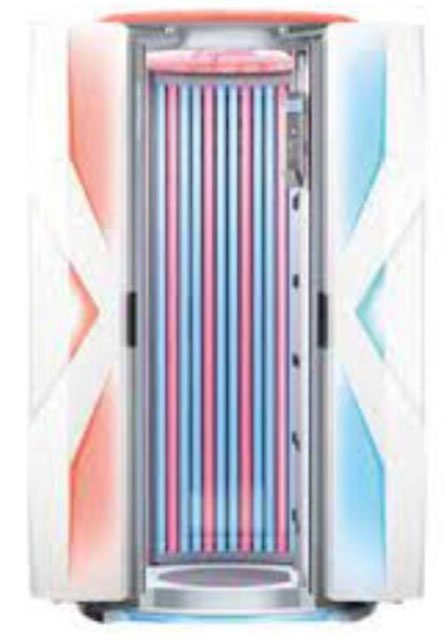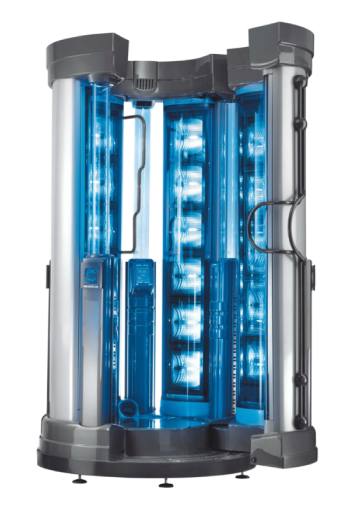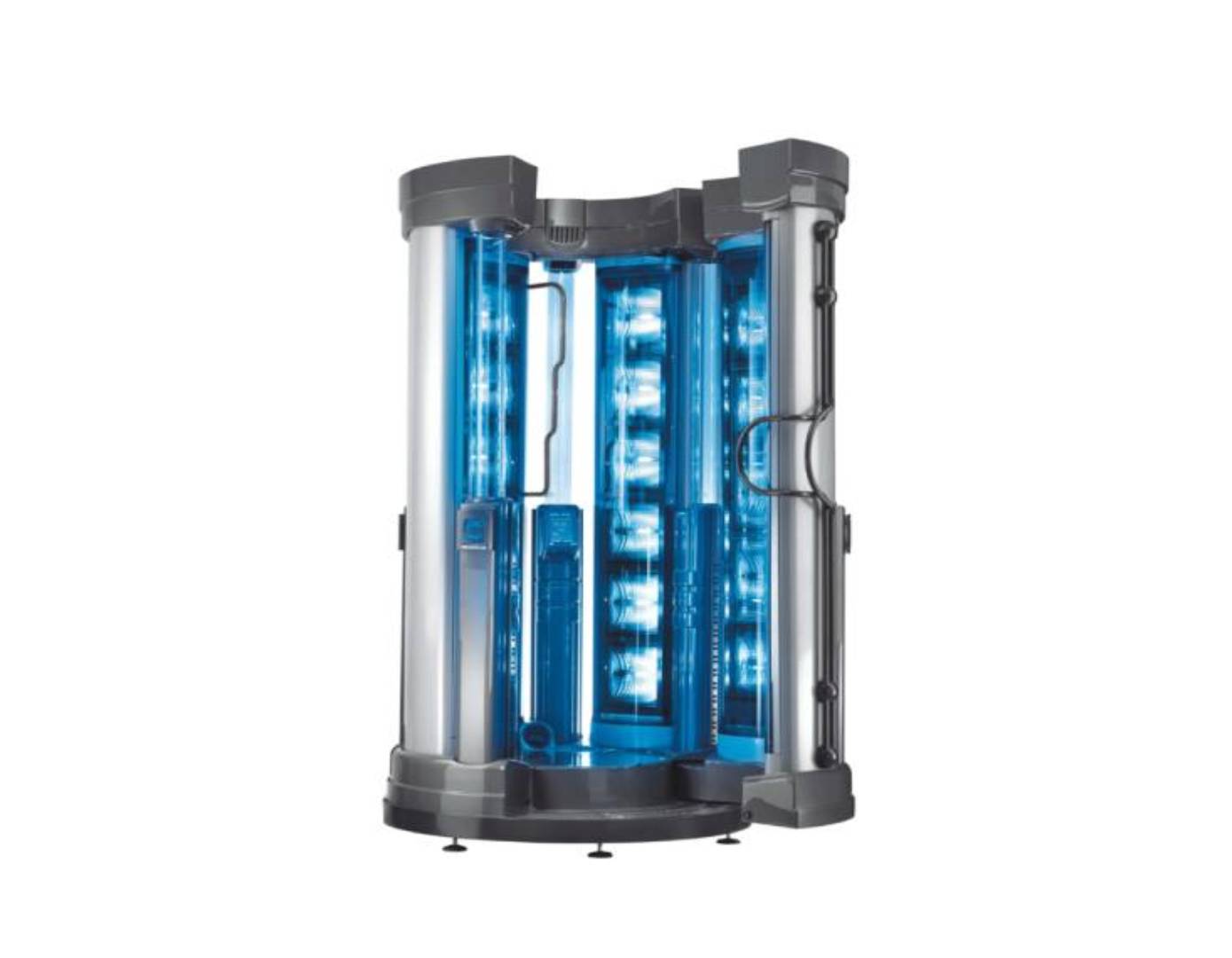The Benefits of Indoor Tanning
You can maintain a deep, dark tan year-round in a fraction of the time it would take to tan outdoors.
Today's tanning equipment is designed to give you measured amounts of ultraviolet light. When tanning outdoors, ultraviolet light levels fluctuate depending on many variables including location, time of day, season, closeness to the equator, and weather condition.
Tan whenever you choose. In good weather or bad, day or night, in a clean, safe environment.
= Uncertain exposure


Clean your skin completely before tanning. Some ingredients in makeup and perfume can make skin more susceptible to sunburn.

Use an indoor tanning lotion. These lotions are specifically designed to accelerate your tan and contain ingredients that supply the skin with nutrients during tanning to help enhance and extend your tanning results.

Apply an indoor tanning moisturizer after your tanning session. A good indoor moisturizer will help keep your beautiful tan by preventing dry skin which exfoliates faster, causing your tan to fade quicker.

Always use eye protection. Failure to use proper eyewear may cause long-term injury to your eyes.

Wait at least two hours to shower after a tanning session.

Increase your exposure time by 2- to 3-minute increments. The key is moderation. Never burn!
Once per day. The F.D.A. will not allow someone to tan more than once in a 24-hour period regardless of exposure time.
Tan times are determined by your skin type, previous exposure time, and what type of bed you are going to use.
The "tan" or pigmentation process occurs in the epidermis, the top skin layer. The epidermis replaces all its skin cells every 28-30 days. Cells in the inner portion of the top skin layer divide themselves, migrate to the surface, gradually die, and slough off. Skin cells contain melanin, and as a result of UV exposure, rise to the surface and flake off. Therefore, a tan can be maintained only by repeated exposure to UV light.
It’s proven that your skin will not only tan better when moisturized but also hold your tan longer. Whether you’re a beginning or advanced tanner, we carry a complete line of skin care products so you can achieve your tanning results while providing exceptional care for your skin. We carry the number one sun care and tanning lines sold in the finest salons worldwide; these products maximize tanning results while helping to prevent burning, skin dehydration, and appearance of wrinkles.
Yes. The Food and Drug Administration (21 CRF 1040.20) requires that protective eyewear which meets its transmission specifications be worn by every tanner.
No, outdoor tanning lotions contain a mineral oil base that will discolor and damage the acrylic surface of the tanning beds.
There exists no known reason why contact lenses may not be worn while tanning indoors. When the eyes are kept closed and proper protective eyewear is worn, UV light is blocked from penetrating the eye or lens. However, the heat generated by indoor tanning equipment could cause the eye to dry a bit, thereby making the lens uncomfortable. Just as one should moisturize the skin after tanning, contact lens wearers may also use the eye drops recommended by his/her optometrist.
There’s no problem with showering just prior to tanning because it clears the skin of any potential barriers that might hinder the tan. Applying a tanning lotion right after a shower will help the lotion absorb more readily into the skin and prepare it for the tan. The exception is with lotions that make your skin heat up and “tingle”—proximity to the tanning session time is a little more critical with those lotions.
Ideally, a person should probably wait a few hours after tanning to take a shower. The reason: Skin takes a while to process the light that it has received into a tan. Taking a shower right after a tan won’t eliminate the tan altogether, but it will minimize the total impact of that individual session.
The epidermis (uppermost section of skin) replaces itself once every 28 to 30 days. The outermost portion of the epidermis, which is ready to shed, also has melanin. That melanin will tan just like the melanin buried deeper in the epidermis. When a person showers or shaves, it sometimes seems like his or her tanning progress is going backward. However, the loss would have occurred anyway; natural grooming speeded up the process. A person shouldn’t get discouraged though. If he or she is tanning, ultraviolet light exposure is generating lots of new melanin that will overcome the loss.
It is difficult to make a simple comparison between the sun and modern indoor tanning equipment. Just as various kinds of indoor tanning lamps and equipment differ in spectral output and energy emitted, the sun's strength is dependent on several factors as well, such as the time of day or year, the latitude, cloud cover, pollution, and reflection. Consequently, there is no formula for relating indoor tanning exposure times to outdoor exposure times.
If a tanner tans in the same level bed all the time, their tan may plateau due to exposure of the same ratio of UVA and UVB rays. Different lamps have different ratios of UVA and UVB light. Once your tan “plateaus”, your body basically needs different doses of UVA and UVB light. To maximize your tan, we suggest tanning in all levels of our equipment and using an indoor tanning lotion.
Working with your doctor on this topic is a wise choice. Every pregnancy has its own considerations so we always suggest you get input from your doctor when considering tanning while pregnant.
At this time, there are no studies that show negative effects of tanning beds on the unborn child, so anything you hear is nothing but myths. The UV light used in tanning beds does not reach the child; therefore, your baby is not at risk.
However, some indirect factors should be considered: During the first trimester, your doctor will advise you not to do anything that will raise your body's temperature, such as hot tubs, saunas, and tanning beds. But, it may be okay to have moderate tanning sessions while lying on your side or standing in a tanning booth to prevent your blood flow from being restricted.
The most important thing to remember is to stay cool and drink plenty of fluids. Your skin during pregnancy is also sensitive to burning, so you should start with short sessions until your body is tanned. Pregnancy and tanning beds is no more harmful to your child than lying in the sun. Just use common sense and make sure you are comfortable.
Four reasons why white spots become noticeable on the body once the tanning process begins:
-Patches of skin which do not tan could be the result of genetic determination. The melanocytes in that certain area may simply not be efficient at producing melanin.
-White spots could also appear due to the presence of a fungus, which lives on the skin's surface. While the fungus is harmless, it does absorb UV light, which would normally penetrate the skin. This fungus did not appear as a result of tanning; it merely becomes noticeable once tanning occurs. It can be remedied through the use of prescription drugs or some other topical lotions.
-White patches of skin, which are often prominent on the shoulder blades and just above the buttocks, can be caused by the pressure from the body as it reclines on a hard surface. This pressure inhibits the flow of blood through that area of the skin. Since blood carries oxygen which is essential to the tanning process, this area does not tan. Periodic body shifting during tanning will make these white patches disappear.
-Certain medications can react unfavorably with exposure to UV light. For example, birth control pills can cause blotches and uneven pigmentation of the skin.
Phototherapy (or use of UV light) has been effective in easing the skin problems common to this condition. There are also many drugs, including tetracycline and Retin-A, which are also widely used for treatment of acne. Because these drugs can render the skin photosensitive, one must avoid UV exposure when medicated. Furthermore, a qualified physician should only administer the use of UV light for acne treatment. The Food and Drug Administration prohibits indoor tanning equipment operators from asserting that equipment use is beneficial for any purpose other than obtaining cosmetic coloring.
The FDA and the Federal Trade Commission forbid making representations regarding the benefits of indoor tanning other than its cosmetic effect. Therefore, one may not make medical claims about indoor tanning equipment.
However, many salon operators report that customers who suffer mild forms of psoriasis improved after indoor tanning.
The Food and Drug Administration forbids making any medical claims in connection with indoor tanning equipment. In addition, there exists no current scientific research which shows that phototherapy is an effective treatment for arthritis.
Some tanners claim that indoor tanning does in fact ease arthritic pain temporarily. Such improvement is most likely attributable to the heat generated by indoor tanning equipment rather than the UV output of the lamps. Again, a salon operator may not promote any health-related aspects to indoor tanning.
There exists a growing body of scientific evidence, which indicates that some people actually require more light exposure in order to function properly. Exposure to bright light, such as that emitted by the mid-day summer sun, causes the brain to suppress the release of the hormone melatonin. Melatonin acts as a depressant in the body if generated during the daytime. Thus, when affected people are exposed to longer hours of bright light, they feel happier, euphoric, and more able to enjoy life. Bright light sources emitting only visible light are now frequently used to successfully treat seasonal affective disorder (SAD) and subsyndromal seasonal affective disorder (SSAD).








